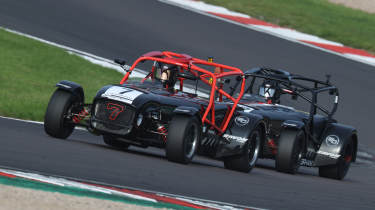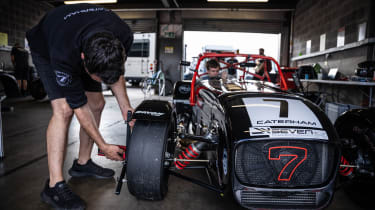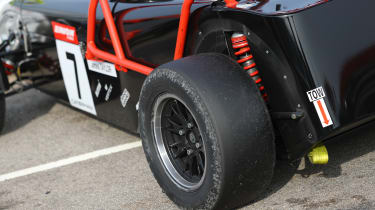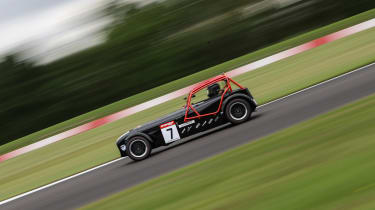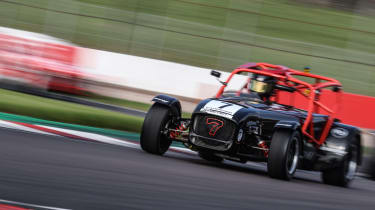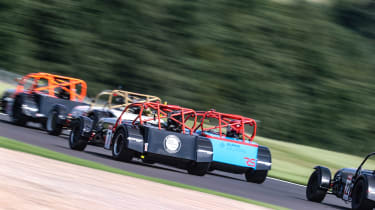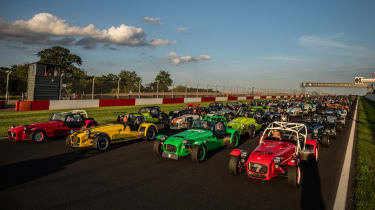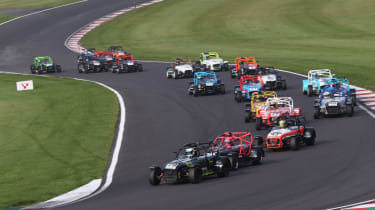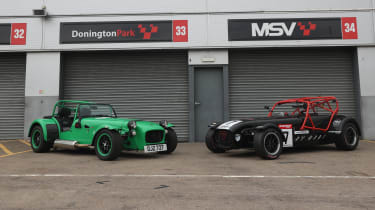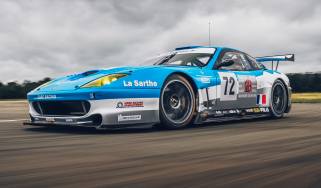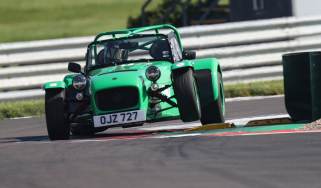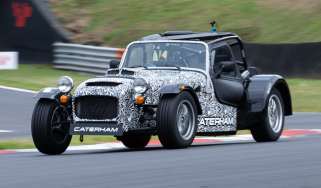Caterham racing is wild: this is what it feels like
What’s it like to race in one of the UK’s closest, fastest, and most intense racing series? evo joins in the fun as a guest in the Caterham Seven UK championship
Night One, Friday:
I wonder if my body is cut out for Caterham racing. I’m at a hotel near Donington Park after a day of testing a rapid Caterham Seven UK Championship car. My neck feels like it’s been through a mangle. The featherweight Seven UK race car generates so much grip on its slick tyres down Donington’s plunging Craner Curves and around its never-ending Coppice Corner that I’ve been needing to call on muscles I forgot I had. Part of me wonders if I can handle actually racing the car tomorrow; the other half can’t wait.
The day started early, climbing into another Seven for the journey to Donington: evo magazine’s Caterham Seven evo25 edition, the special Seven celebrating Caterham’s 50th anniversary and evo’s 25th, currently a part of the magazine’s Fast Fleet.
Fitting crash helmet, racing gear, an overnight bag and other paraphernalia into the boot and passenger side of the cockpit wasn’t the work of a moment but it’s surprising how much you can fit in a Seven with a bit of creative squashing.
We’re taking the evo25 car to meet its racing cousin, the 420R race car which forms the grid for the Caterham Seven Championship UK (often abbreviated to CSUK). I’m hoping the miles in the evo road car will help me get to grips with the race car more easily, as the CSUK championship is not only the top tier of Caterham’s racing ladder but renowned as being one of the hardest-fought, fastest and feistiest one-make championships in the country (or any country, for that matter). Slick tyres, sequential gears and lap times which can come close to BTCC cars on certain circuits.
I’m joining the grid as a guest at the Donington Park round, which is also the setting for Caterham’s 50th Anniversary Festival celebrations. Aside from music, displays, hundreds of Sevens (which will later break a world record in convoy around the circuit) and a general party atmosphere, there’s also the full spectrum of Caterham’s racing championships running throughout the weekend, from the absolute-beginners Academy series all the way to the flagship CSUK.
Meeting the car in the Donington garage, there really is plenty in common with the evo25 road car and the CSUK race car. Both share, barring some detail differences, very similar 2.0-litre Ford Duratec engines in 420R tune. The race car actually puts out slightly less power than our road car, but a little more torque.
Essentially the same Bilstein dampers too, only they’re fixed by regulations in the racer and adjustable in our road car. The race car has a beefier rollcage than our car’s road/track hybrid cage, necessitating getting in through the roof.
Once you’re inside, you sit low in a slim shell, harnessed firmly into place (and with your wrists tethered with straps to the harnesses too, the purpose, dauntingly, to stop an errant arm being flung outside the car by G-forces in a crash). A race-spec rev counter and data display sits just ahead of a tiny, suede-trimmed Momo steering wheel identical to the road car’s. No windscreen: the mirrors are attached directly to the rollcage’s A pillars. The central rear-view mirror is an enormously wide, slightly bowled surface, to give advance warning of incoming divebomb outbraking moves.
A fixed tonneau panel sits over the passenger side of the cockpit, and where normally your left hand would reach for a H-pattern gearshift, it’s a sequential racing gearbox in the race car. No need to lift to change up: keep the throttle pinned, and the ignition-cut system system does the rest as you pull the lever back, accompanied by a weird, but addictive, blat sound from the exhaust.
I’ve driven this black car, with its appropriate no.7 race number, once before in a test session last year when Caterham launched the 420 Cup road car, its road-legal equivalent (which shares more than a few of its components with the evo25 car). I remember thinking at the time that it was one of the most fun vehicles I’d ever driven in my life. Maybe even the most fun.
Twelve months on, that conclusion hasn’t changed. The clutch is light, easy, and apart from the whining straight-cut gears it’s no more difficult to drive around the paddock than the road car. On track, the sequential shift is a blast: you need to give the lever a good strong pull on the way up, and you need to use the clutch on the way down, along with a blip on the throttle to match the revs – if you can find the time. You’re not on the brakes for very long.
With so little weight and inertia, the CSUK is a missile, and being sat so low in the car, so close to the rear wheels and dictating the car’s path with a combination of your wrists and palms on that tiny steering wheel and your right foot on the pedals, it’s an unadulterated joy to drive around Donington’s flowing elevation changes. There’s more understeer than when I last drove the car, which it seems is a curious quirk of these tyres, these cars and Donington’s surface and corners; those who’ve raced Caterhams for some years say it’s just how things are at Donington. Caterham’s engineer Joe Marsh makes the first of many set-up changes through the weekend.
Craner Curves are taken flat, and I honestly feel like my head is going to be pulled from my shoulders, despite wearing a lightweight carbonfibre helmet. (Being honest, I bought it partly because it was in the sales, and partly because I knew I’d be racing the Seven, and I got a bit scared after watching some crashes on YouTube). Joe screws the headrest support, a foam-padded metal plate, a little further for the next session so I can push my head back into it and relieve some of the effort.
Elated with the sensation of driving the car as well as knackered from the physicality of it, I sleep very well.
Day Two: Saturday
Racing Caterhams is clearly a black art. One thing unique to Seven racing is the need for a tow in qualifying: with the Seven being such a draggy, open-wheeled shape, the slipstream effect you get from other cars is like nothing else I’ve experienced. Follow another car and you really feel yourself being drafted along, like your car’s being dragged forward by a tractor beam. I suppose it’s akin to DRS in Formula 1; only it’s active all the time in Caterham racing. And there’s a lot more overtaking in a 15-minute CSUK race than in an average 90-minute Grand Prix. Probably an F1 season, for that matter.
In qualifying, a tow can make all the difference between a slow time and a competitive one. All of the drivers are well aware of this, ducking into the pitlane if they sense a driver’s tucked into their slipstream during qualifying, while being savvy enough to find a car of their own to follow.
I abandon a few laps in clear air in order to find another car to follow, only for them to immediately peel into the pitlane or off-line when they see me in the mirrors. Clearly you need to get up very early to be on the pace in CSUK.
I only manage to find one lap in another car’s slipstream shortly before the flag falls, and line up 15th out of 20 cars.
So strong is the slipstream effect that the top ten must go on to a separate Superpole session, so as to run in clear air. The Superpole laptimes are around 0.8sec slower than when the pack are running in a peloton in the main qualifying session, demonstrating just what a difference the slipstream makes.
Seven racing being a specialised art, Caterham sub-divides the championship table into two classes: Pro for seasoned drivers and Am for those with less experience in Sevens. That being the case, I’m in the Am class, with ten other drivers.
Lights out for Race 1 and 15 minutes of the most intense driving I’ve ever experienced in my life. The slipstream effect means the field never really spreads out, separating into two closely-packed, tightly-fought groups. With the ability to run side by side more easily than in other racing cars, overtaking moves go on for two or three corners, maybe more.
The racing is almost impossibly close, inches apart – or less at times. After a couple of laps, several cars are missing cycle wings after touching wheels. Drivers climb up the order, and fall down it with incredible frequency as moves and mistakes are made, the running order yo-yoing throughout the race. There’s a second start too, as the race is red-flagged and restarted after a heavy, happily non-injurous crash further up the field.
Although for fleeting moments I get into the top ten and run third in the Am class at one point, it’s not long before I’m shuffled down the field: make one mistake, or lose one position, and you’re quickly swallowed by the pack. By the time all the shuffling is done, and losing another position on the final lap, I’m 16th over the line. Which is, ahem, last of the remaining runners. And yet the field is tightly packed enough that the classic commentator’s cliche about being able to throw a blanket over the field really is accurate, even at the end of the race. This is seriously close racing.
And there are two races still to go.
Night Two: Saturday
But not before a special parade for Caterham’s gold anniversary. Sevens from all over the country (and beyond) and from every decade of Caterham’s story since it took over the Lotus Seven in 1973 get together in a gigantic conga line to form one continuous parade around the Donington circuit.
With the sun setting over its rolling surfaces, it’s quite a sight. A particularly special one viewed over the nose of the evo25 car: we’re right near the front of the parade, just behind Caterham CEO Bob Laishley in a Seven 420 Cup; and alongside ‘LegoCat,’ the wild, bright yellow 620R on which Lego’s Caterham kit series was based.
Behind all of us, another 400 or so Sevens, all bathed in the setting sun as we roll to a halt at the finishing line. It’s one of the most special driving memories I’ll have, and all below 30mph.
Over live music and food, I’m struck by how friendly and welcoming everybody in the Caterham racing fraternity is. There’s a real family atmosphere.
The party’s still in full swing when I slink off in the evo Seven, having extricated it from its position on display. Back at the hotel, I ask for a bag of ice from the kitchen to put on my hand, swollen from the sequential shift and clobbering Donington’s kerbs.
Day Three: Sunday
Parc ferme, following Race 2. ‘I see you’re sporting the traditional missing wheelarch,’ smiles championship photographer Jon Bryant, motioning to ‘my’ car’s exposed right-rear wheel. I’d resolved to sharpen my elbows a bit more after yesterday’s 16th-place finish. I’ve improved, albeit only one position, to 15th out of 20 finishers, and got stuck into the racing with less timidity, including accidentally touching wheels with another car through Coppice, hence the missing wing. Racing in the midst of the pack is as sheer an adrenaline rush as I’ve ever experienced: racing nose-to-tail and wheel-to-wheel, it’s closer to karting than car racing. But in the most fun-to-drive cars imaginable.
One thing I still can’t shake off is understeer, and Joe continues to tweak the set-up accordingly. Something quite unique to the Seven Championship is the need to keep fine-tuning the setup through the weekend, from practice through qualifying right the way through to the final race, as competitors must race on the same set of tyres throughout the weekend – as they wear the balance of the car continuously changes.
Joe manages to keep the balance of the car sweet as the tyres continually get a pasting, and as the final race begins it feels as keen and positive as it did on fresh rubber at the start of the Saturday.
The racing is faster and more intense than ever; I remember whooping out loud with sheer exhilaration pulling for another gear in a pack of five cars, all going for the same piece of tarmac on the climb up the hill out of the Old Hairpin.
The final chicane is like a high-speed traffic jam, Caterhams trying to filter from a side-by-side peloton down the back straight into one line between the kerbs and tyre stacks. I decide to back off early at the end of the straight to avoid getting caught in the gaggle of cars in the chicane, and to get a good run onto the start/finish straight in the hope of making a move at the first corner. It works too well, and I catch the cars so rapidly on the chicane’s exit that I tag the back of the car in front and take to the grass beyond the exit kerb in avoidance. (‘At least you kept your foot in,’ says photographer Jon afterwards; ‘you showered me with grass.’ He still got the shot.)
A quick wiggle of the steering to clean the tyres, clear my head and I set about trying to regain the ground I’ve lost. That turns out to be a blessing in disguise, however: ahead there’s a cloud of smoke, which it turns out is front-runner Jake Swann’s engine letting go in a big way, leaving oil on the run down the Craner Curves. Suddenly ahead all is a sea of spinning Caterhams, losing control on the oil. The ground I’ve lost gives me just enough time to see what’s happening, back off and keep the steering as straight as possible. The car shimmies a little on the oil but I’ve made it through safely. Had I been a few metres up the road I’d have been among the cars exiting stage right onto the grass.
Red flags fly for the oil to be cleared, and thankfully nobody has hit anything in the accident, whether the barriers or another car. Nearly all of the cars are able to take the restart for a four-lap sprint to the flag. To give an idea of the closeness of the field, I cross the line in 14th, 4.3 seconds behind the winner.
I’m exhausted and exuberant after some of the most breathlessly exciting driving I’ve ever encountered. The CSUK is not for the faint-hearted but its a driving thrill like little else. And I don’t even have any aches and pains that evening. Finally, it seems my body has adapted.
Postscript: Day Four, Monday
The Caterham 50th Anniversary Festival concludes with a Sevens-only trackday, this time using Donington’s full-length, bonus-hairpins Grand Prix layout.
I’m able to take to the track in the evo25 car to see just how similar it feels to its racing cousin. The answer is far, far closer than I ever expected.
Although the evo25 car is wonderful fun, I expected it to feel like a bit of a comedown: how could it be anything else after the slick-shod, sequential-geared CSUK racer? Yet it really was a very close experience, both in terms of excitement and how damn quick it is. On semi-slick road legal Avon tyres, the evo25 with its 420R engine is significantly faster than full race-spec Caterhams from the lower, Sigma-engined classes and it feels right at home at Donington. The five-speed manual gearbox is slower than the six-speed race ’box, of course, but it’s still a delight to flick the lever around the gate.
The shared DNA with the 420 race car is real and tangible. And, it being one of the most fun things I’ve ever driven, praise doesn’t come much higher.
